Australia's Solar Power Market: Demand, Supply, and Government Control
VerifiedAdded on 2023/06/11
|9
|3309
|371
Report
AI Summary
This report examines the demand and supply dynamics of solar power in Australia, highlighting the rapid growth of the solar industry and its current capacity of 8073 Megawatts. It identifies key drivers of demand, including increased environmental awareness and government initiatives, particularly in South Australia, alongside factors influencing supply, such as government investment and private sector involvement in research and development. The report emphasizes the significant role of the Australian government in shaping both demand and supply through policies like feed-in tariff schemes, grants for schools, and incentives for solar home installations, with a goal to increase solar energy contribution to 20% by 2022. It also notes the reduction in the cost of PV cells and the increasing adoption of solar power, facilitated by government support and technological advancements, aiming for a future where solar energy can effectively substitute conventional sources.
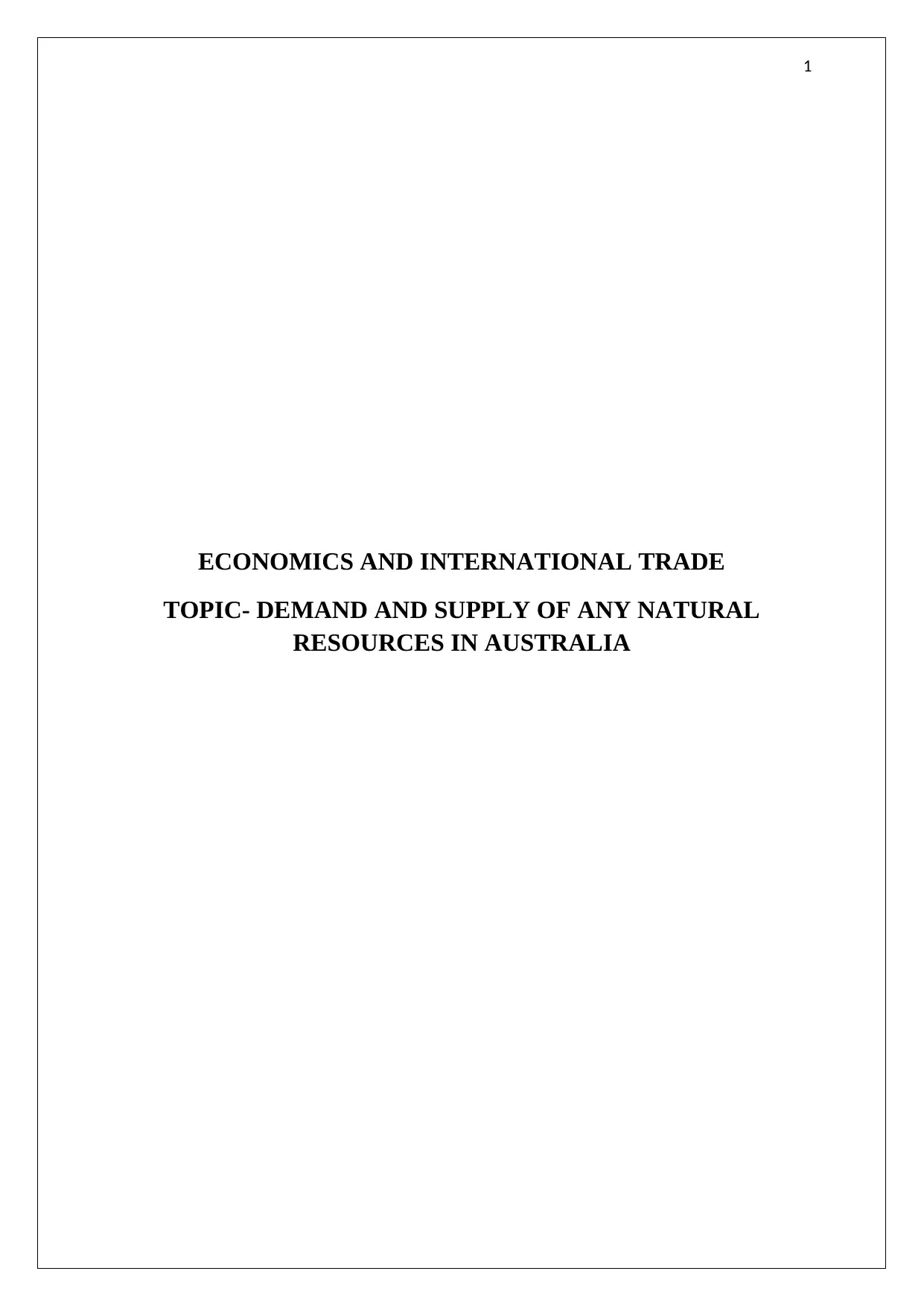
1
ECONOMICS AND INTERNATIONAL TRADE
TOPIC- DEMAND AND SUPPLY OF ANY NATURAL
RESOURCES IN AUSTRALIA
ECONOMICS AND INTERNATIONAL TRADE
TOPIC- DEMAND AND SUPPLY OF ANY NATURAL
RESOURCES IN AUSTRALIA
Paraphrase This Document
Need a fresh take? Get an instant paraphrase of this document with our AI Paraphraser
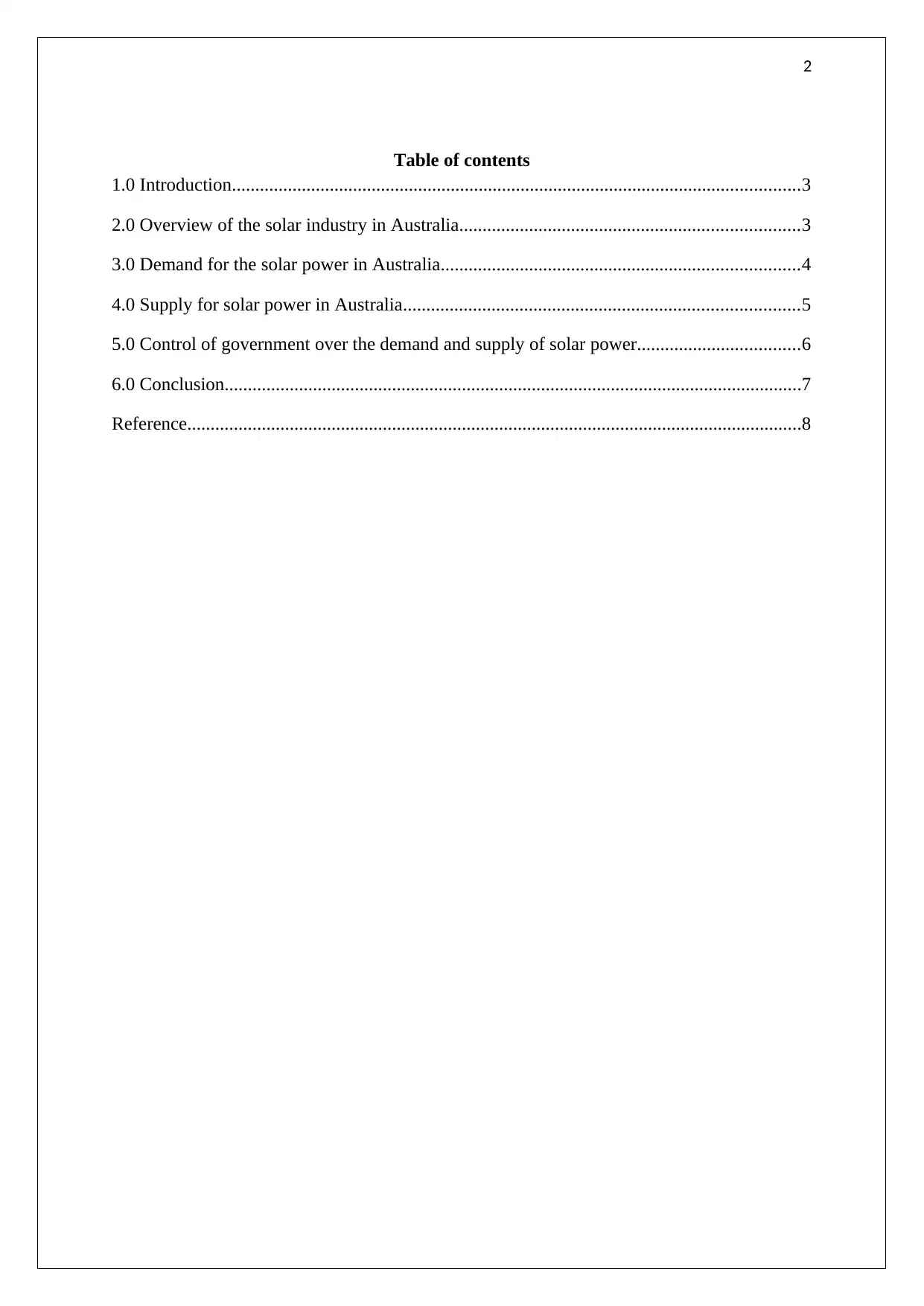
2
Table of contents
1.0 Introduction..........................................................................................................................3
2.0 Overview of the solar industry in Australia.........................................................................3
3.0 Demand for the solar power in Australia.............................................................................4
4.0 Supply for solar power in Australia.....................................................................................5
5.0 Control of government over the demand and supply of solar power...................................6
6.0 Conclusion............................................................................................................................7
Reference....................................................................................................................................8
Table of contents
1.0 Introduction..........................................................................................................................3
2.0 Overview of the solar industry in Australia.........................................................................3
3.0 Demand for the solar power in Australia.............................................................................4
4.0 Supply for solar power in Australia.....................................................................................5
5.0 Control of government over the demand and supply of solar power...................................6
6.0 Conclusion............................................................................................................................7
Reference....................................................................................................................................8
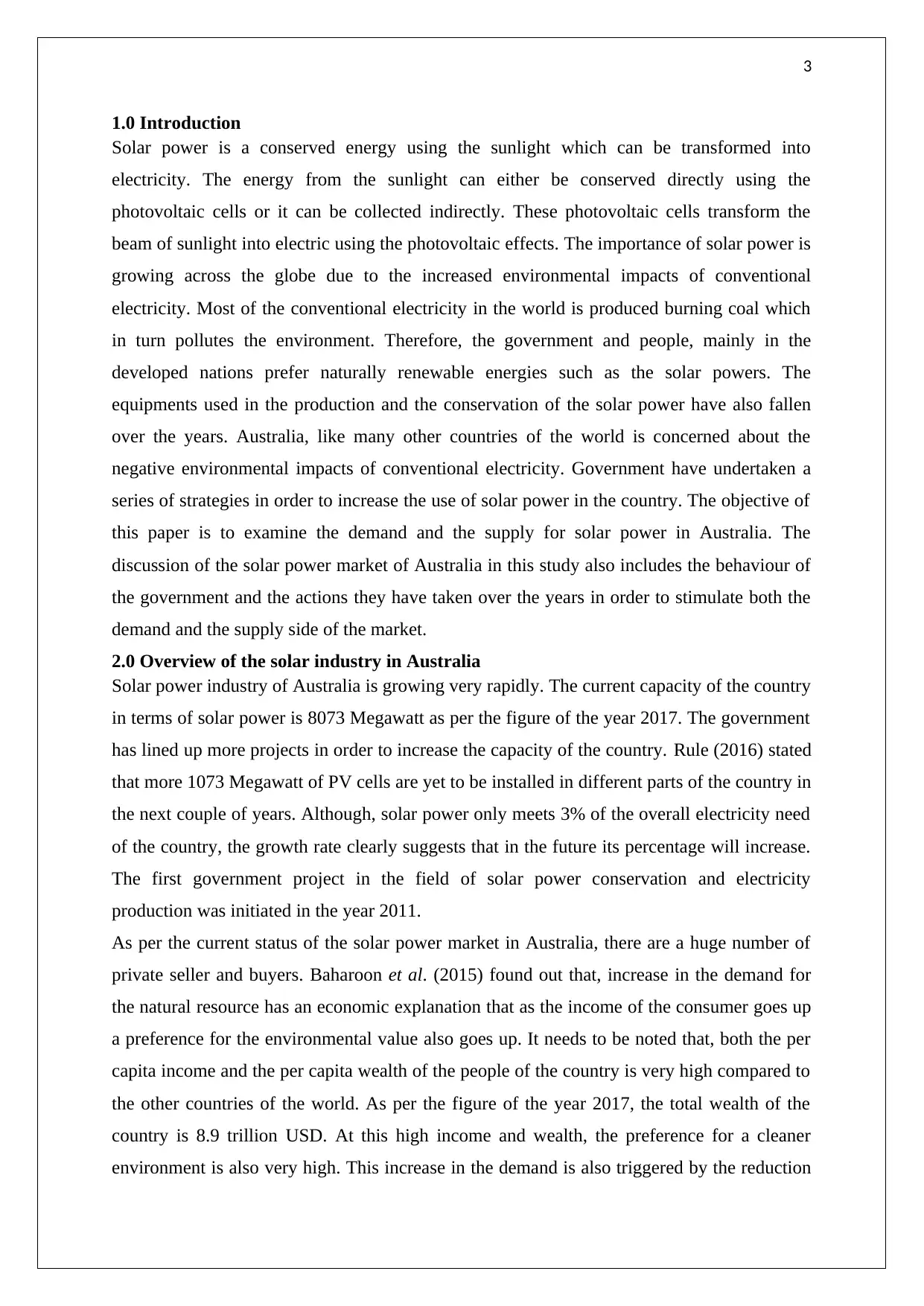
3
1.0 Introduction
Solar power is a conserved energy using the sunlight which can be transformed into
electricity. The energy from the sunlight can either be conserved directly using the
photovoltaic cells or it can be collected indirectly. These photovoltaic cells transform the
beam of sunlight into electric using the photovoltaic effects. The importance of solar power is
growing across the globe due to the increased environmental impacts of conventional
electricity. Most of the conventional electricity in the world is produced burning coal which
in turn pollutes the environment. Therefore, the government and people, mainly in the
developed nations prefer naturally renewable energies such as the solar powers. The
equipments used in the production and the conservation of the solar power have also fallen
over the years. Australia, like many other countries of the world is concerned about the
negative environmental impacts of conventional electricity. Government have undertaken a
series of strategies in order to increase the use of solar power in the country. The objective of
this paper is to examine the demand and the supply for solar power in Australia. The
discussion of the solar power market of Australia in this study also includes the behaviour of
the government and the actions they have taken over the years in order to stimulate both the
demand and the supply side of the market.
2.0 Overview of the solar industry in Australia
Solar power industry of Australia is growing very rapidly. The current capacity of the country
in terms of solar power is 8073 Megawatt as per the figure of the year 2017. The government
has lined up more projects in order to increase the capacity of the country. Rule (2016) stated
that more 1073 Megawatt of PV cells are yet to be installed in different parts of the country in
the next couple of years. Although, solar power only meets 3% of the overall electricity need
of the country, the growth rate clearly suggests that in the future its percentage will increase.
The first government project in the field of solar power conservation and electricity
production was initiated in the year 2011.
As per the current status of the solar power market in Australia, there are a huge number of
private seller and buyers. Baharoon et al. (2015) found out that, increase in the demand for
the natural resource has an economic explanation that as the income of the consumer goes up
a preference for the environmental value also goes up. It needs to be noted that, both the per
capita income and the per capita wealth of the people of the country is very high compared to
the other countries of the world. As per the figure of the year 2017, the total wealth of the
country is 8.9 trillion USD. At this high income and wealth, the preference for a cleaner
environment is also very high. This increase in the demand is also triggered by the reduction
1.0 Introduction
Solar power is a conserved energy using the sunlight which can be transformed into
electricity. The energy from the sunlight can either be conserved directly using the
photovoltaic cells or it can be collected indirectly. These photovoltaic cells transform the
beam of sunlight into electric using the photovoltaic effects. The importance of solar power is
growing across the globe due to the increased environmental impacts of conventional
electricity. Most of the conventional electricity in the world is produced burning coal which
in turn pollutes the environment. Therefore, the government and people, mainly in the
developed nations prefer naturally renewable energies such as the solar powers. The
equipments used in the production and the conservation of the solar power have also fallen
over the years. Australia, like many other countries of the world is concerned about the
negative environmental impacts of conventional electricity. Government have undertaken a
series of strategies in order to increase the use of solar power in the country. The objective of
this paper is to examine the demand and the supply for solar power in Australia. The
discussion of the solar power market of Australia in this study also includes the behaviour of
the government and the actions they have taken over the years in order to stimulate both the
demand and the supply side of the market.
2.0 Overview of the solar industry in Australia
Solar power industry of Australia is growing very rapidly. The current capacity of the country
in terms of solar power is 8073 Megawatt as per the figure of the year 2017. The government
has lined up more projects in order to increase the capacity of the country. Rule (2016) stated
that more 1073 Megawatt of PV cells are yet to be installed in different parts of the country in
the next couple of years. Although, solar power only meets 3% of the overall electricity need
of the country, the growth rate clearly suggests that in the future its percentage will increase.
The first government project in the field of solar power conservation and electricity
production was initiated in the year 2011.
As per the current status of the solar power market in Australia, there are a huge number of
private seller and buyers. Baharoon et al. (2015) found out that, increase in the demand for
the natural resource has an economic explanation that as the income of the consumer goes up
a preference for the environmental value also goes up. It needs to be noted that, both the per
capita income and the per capita wealth of the people of the country is very high compared to
the other countries of the world. As per the figure of the year 2017, the total wealth of the
country is 8.9 trillion USD. At this high income and wealth, the preference for a cleaner
environment is also very high. This increase in the demand is also triggered by the reduction
⊘ This is a preview!⊘
Do you want full access?
Subscribe today to unlock all pages.

Trusted by 1+ million students worldwide
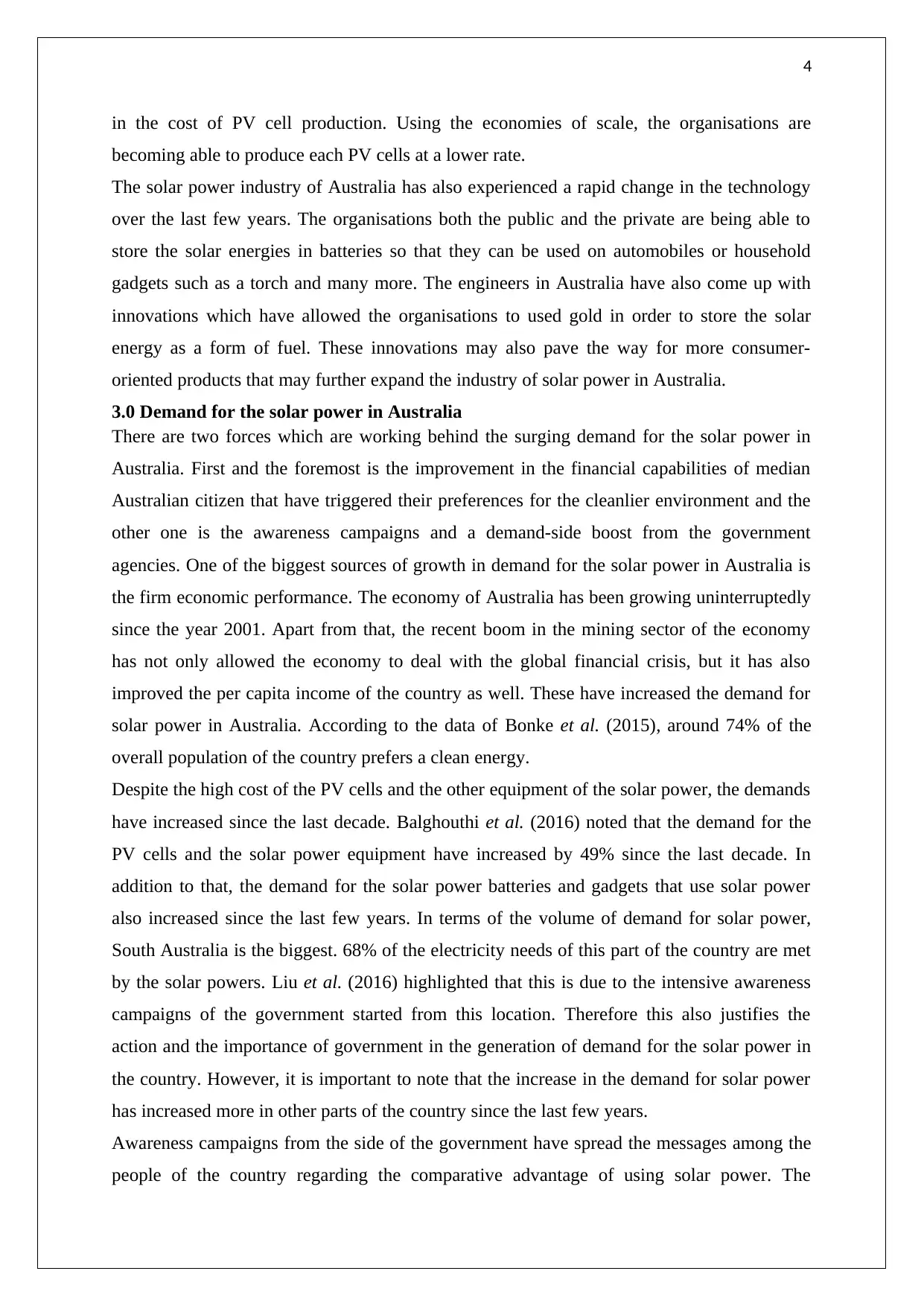
4
in the cost of PV cell production. Using the economies of scale, the organisations are
becoming able to produce each PV cells at a lower rate.
The solar power industry of Australia has also experienced a rapid change in the technology
over the last few years. The organisations both the public and the private are being able to
store the solar energies in batteries so that they can be used on automobiles or household
gadgets such as a torch and many more. The engineers in Australia have also come up with
innovations which have allowed the organisations to used gold in order to store the solar
energy as a form of fuel. These innovations may also pave the way for more consumer-
oriented products that may further expand the industry of solar power in Australia.
3.0 Demand for the solar power in Australia
There are two forces which are working behind the surging demand for the solar power in
Australia. First and the foremost is the improvement in the financial capabilities of median
Australian citizen that have triggered their preferences for the cleanlier environment and the
other one is the awareness campaigns and a demand-side boost from the government
agencies. One of the biggest sources of growth in demand for the solar power in Australia is
the firm economic performance. The economy of Australia has been growing uninterruptedly
since the year 2001. Apart from that, the recent boom in the mining sector of the economy
has not only allowed the economy to deal with the global financial crisis, but it has also
improved the per capita income of the country as well. These have increased the demand for
solar power in Australia. According to the data of Bonke et al. (2015), around 74% of the
overall population of the country prefers a clean energy.
Despite the high cost of the PV cells and the other equipment of the solar power, the demands
have increased since the last decade. Balghouthi et al. (2016) noted that the demand for the
PV cells and the solar power equipment have increased by 49% since the last decade. In
addition to that, the demand for the solar power batteries and gadgets that use solar power
also increased since the last few years. In terms of the volume of demand for solar power,
South Australia is the biggest. 68% of the electricity needs of this part of the country are met
by the solar powers. Liu et al. (2016) highlighted that this is due to the intensive awareness
campaigns of the government started from this location. Therefore this also justifies the
action and the importance of government in the generation of demand for the solar power in
the country. However, it is important to note that the increase in the demand for solar power
has increased more in other parts of the country since the last few years.
Awareness campaigns from the side of the government have spread the messages among the
people of the country regarding the comparative advantage of using solar power. The
in the cost of PV cell production. Using the economies of scale, the organisations are
becoming able to produce each PV cells at a lower rate.
The solar power industry of Australia has also experienced a rapid change in the technology
over the last few years. The organisations both the public and the private are being able to
store the solar energies in batteries so that they can be used on automobiles or household
gadgets such as a torch and many more. The engineers in Australia have also come up with
innovations which have allowed the organisations to used gold in order to store the solar
energy as a form of fuel. These innovations may also pave the way for more consumer-
oriented products that may further expand the industry of solar power in Australia.
3.0 Demand for the solar power in Australia
There are two forces which are working behind the surging demand for the solar power in
Australia. First and the foremost is the improvement in the financial capabilities of median
Australian citizen that have triggered their preferences for the cleanlier environment and the
other one is the awareness campaigns and a demand-side boost from the government
agencies. One of the biggest sources of growth in demand for the solar power in Australia is
the firm economic performance. The economy of Australia has been growing uninterruptedly
since the year 2001. Apart from that, the recent boom in the mining sector of the economy
has not only allowed the economy to deal with the global financial crisis, but it has also
improved the per capita income of the country as well. These have increased the demand for
solar power in Australia. According to the data of Bonke et al. (2015), around 74% of the
overall population of the country prefers a clean energy.
Despite the high cost of the PV cells and the other equipment of the solar power, the demands
have increased since the last decade. Balghouthi et al. (2016) noted that the demand for the
PV cells and the solar power equipment have increased by 49% since the last decade. In
addition to that, the demand for the solar power batteries and gadgets that use solar power
also increased since the last few years. In terms of the volume of demand for solar power,
South Australia is the biggest. 68% of the electricity needs of this part of the country are met
by the solar powers. Liu et al. (2016) highlighted that this is due to the intensive awareness
campaigns of the government started from this location. Therefore this also justifies the
action and the importance of government in the generation of demand for the solar power in
the country. However, it is important to note that the increase in the demand for solar power
has increased more in other parts of the country since the last few years.
Awareness campaigns from the side of the government have spread the messages among the
people of the country regarding the comparative advantage of using solar power. The
Paraphrase This Document
Need a fresh take? Get an instant paraphrase of this document with our AI Paraphraser
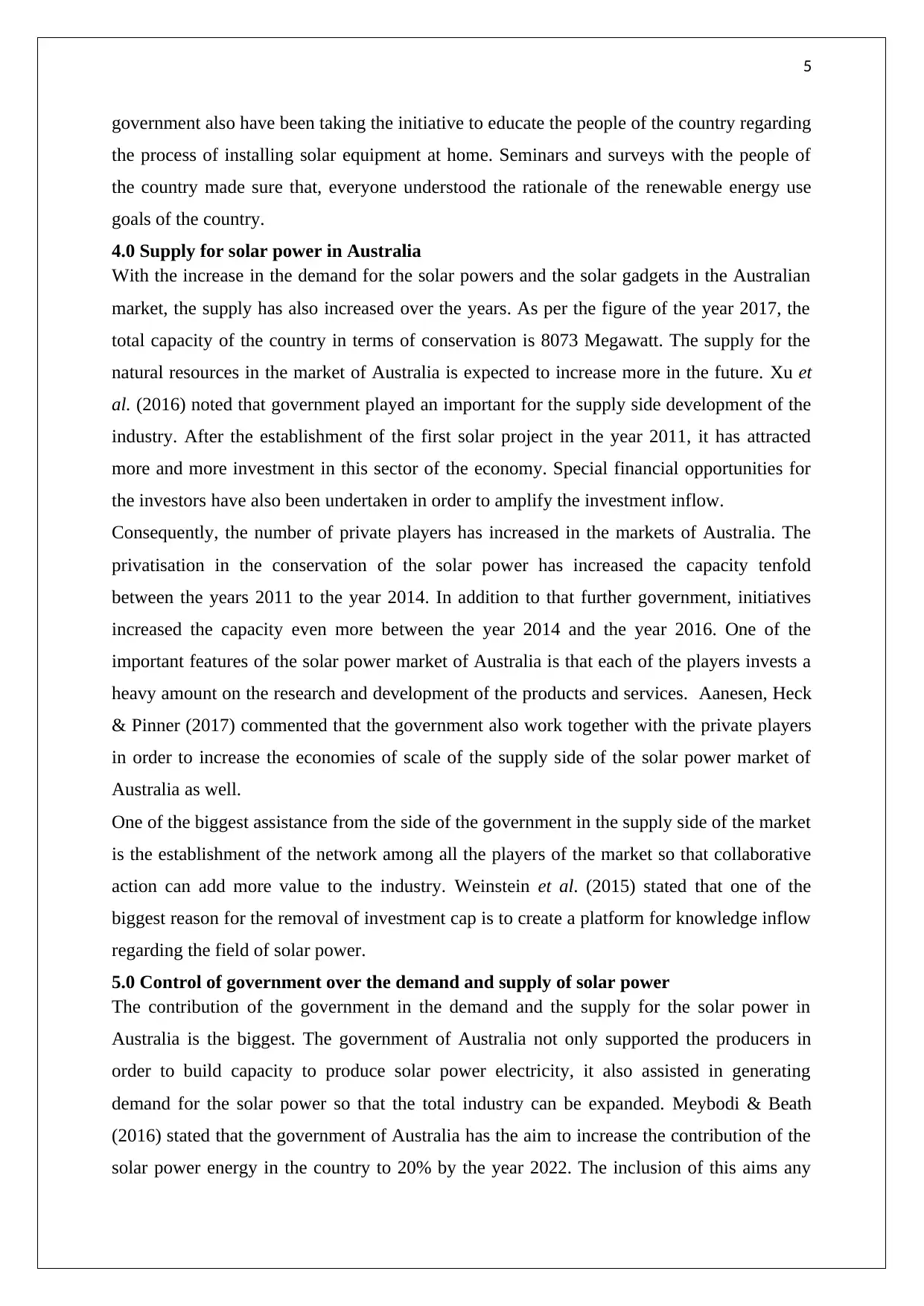
5
government also have been taking the initiative to educate the people of the country regarding
the process of installing solar equipment at home. Seminars and surveys with the people of
the country made sure that, everyone understood the rationale of the renewable energy use
goals of the country.
4.0 Supply for solar power in Australia
With the increase in the demand for the solar powers and the solar gadgets in the Australian
market, the supply has also increased over the years. As per the figure of the year 2017, the
total capacity of the country in terms of conservation is 8073 Megawatt. The supply for the
natural resources in the market of Australia is expected to increase more in the future. Xu et
al. (2016) noted that government played an important for the supply side development of the
industry. After the establishment of the first solar project in the year 2011, it has attracted
more and more investment in this sector of the economy. Special financial opportunities for
the investors have also been undertaken in order to amplify the investment inflow.
Consequently, the number of private players has increased in the markets of Australia. The
privatisation in the conservation of the solar power has increased the capacity tenfold
between the years 2011 to the year 2014. In addition to that further government, initiatives
increased the capacity even more between the year 2014 and the year 2016. One of the
important features of the solar power market of Australia is that each of the players invests a
heavy amount on the research and development of the products and services. Aanesen, Heck
& Pinner (2017) commented that the government also work together with the private players
in order to increase the economies of scale of the supply side of the solar power market of
Australia as well.
One of the biggest assistance from the side of the government in the supply side of the market
is the establishment of the network among all the players of the market so that collaborative
action can add more value to the industry. Weinstein et al. (2015) stated that one of the
biggest reason for the removal of investment cap is to create a platform for knowledge inflow
regarding the field of solar power.
5.0 Control of government over the demand and supply of solar power
The contribution of the government in the demand and the supply for the solar power in
Australia is the biggest. The government of Australia not only supported the producers in
order to build capacity to produce solar power electricity, it also assisted in generating
demand for the solar power so that the total industry can be expanded. Meybodi & Beath
(2016) stated that the government of Australia has the aim to increase the contribution of the
solar power energy in the country to 20% by the year 2022. The inclusion of this aims any
government also have been taking the initiative to educate the people of the country regarding
the process of installing solar equipment at home. Seminars and surveys with the people of
the country made sure that, everyone understood the rationale of the renewable energy use
goals of the country.
4.0 Supply for solar power in Australia
With the increase in the demand for the solar powers and the solar gadgets in the Australian
market, the supply has also increased over the years. As per the figure of the year 2017, the
total capacity of the country in terms of conservation is 8073 Megawatt. The supply for the
natural resources in the market of Australia is expected to increase more in the future. Xu et
al. (2016) noted that government played an important for the supply side development of the
industry. After the establishment of the first solar project in the year 2011, it has attracted
more and more investment in this sector of the economy. Special financial opportunities for
the investors have also been undertaken in order to amplify the investment inflow.
Consequently, the number of private players has increased in the markets of Australia. The
privatisation in the conservation of the solar power has increased the capacity tenfold
between the years 2011 to the year 2014. In addition to that further government, initiatives
increased the capacity even more between the year 2014 and the year 2016. One of the
important features of the solar power market of Australia is that each of the players invests a
heavy amount on the research and development of the products and services. Aanesen, Heck
& Pinner (2017) commented that the government also work together with the private players
in order to increase the economies of scale of the supply side of the solar power market of
Australia as well.
One of the biggest assistance from the side of the government in the supply side of the market
is the establishment of the network among all the players of the market so that collaborative
action can add more value to the industry. Weinstein et al. (2015) stated that one of the
biggest reason for the removal of investment cap is to create a platform for knowledge inflow
regarding the field of solar power.
5.0 Control of government over the demand and supply of solar power
The contribution of the government in the demand and the supply for the solar power in
Australia is the biggest. The government of Australia not only supported the producers in
order to build capacity to produce solar power electricity, it also assisted in generating
demand for the solar power so that the total industry can be expanded. Meybodi & Beath
(2016) stated that the government of Australia has the aim to increase the contribution of the
solar power energy in the country to 20% by the year 2022. The inclusion of this aims any
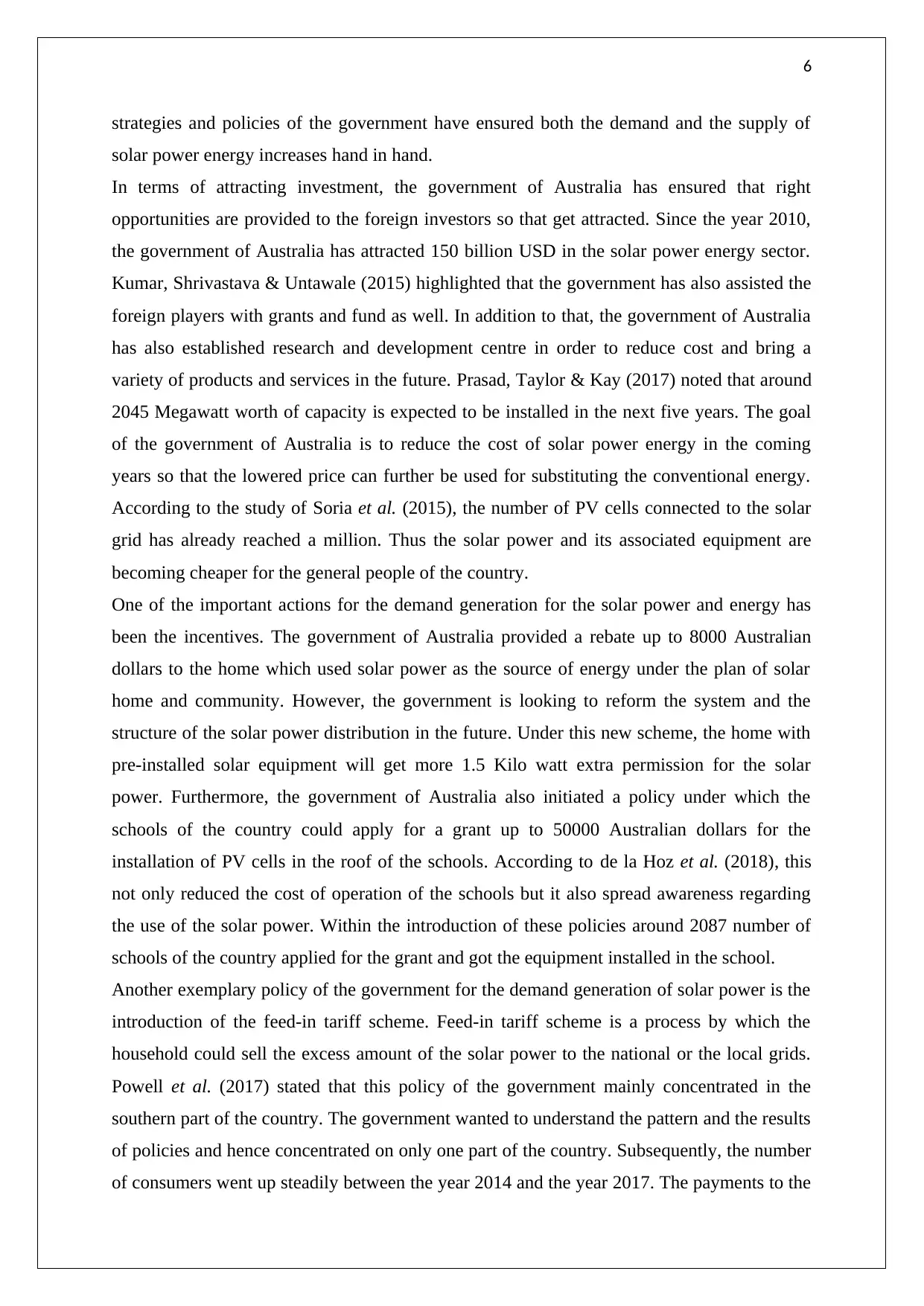
6
strategies and policies of the government have ensured both the demand and the supply of
solar power energy increases hand in hand.
In terms of attracting investment, the government of Australia has ensured that right
opportunities are provided to the foreign investors so that get attracted. Since the year 2010,
the government of Australia has attracted 150 billion USD in the solar power energy sector.
Kumar, Shrivastava & Untawale (2015) highlighted that the government has also assisted the
foreign players with grants and fund as well. In addition to that, the government of Australia
has also established research and development centre in order to reduce cost and bring a
variety of products and services in the future. Prasad, Taylor & Kay (2017) noted that around
2045 Megawatt worth of capacity is expected to be installed in the next five years. The goal
of the government of Australia is to reduce the cost of solar power energy in the coming
years so that the lowered price can further be used for substituting the conventional energy.
According to the study of Soria et al. (2015), the number of PV cells connected to the solar
grid has already reached a million. Thus the solar power and its associated equipment are
becoming cheaper for the general people of the country.
One of the important actions for the demand generation for the solar power and energy has
been the incentives. The government of Australia provided a rebate up to 8000 Australian
dollars to the home which used solar power as the source of energy under the plan of solar
home and community. However, the government is looking to reform the system and the
structure of the solar power distribution in the future. Under this new scheme, the home with
pre-installed solar equipment will get more 1.5 Kilo watt extra permission for the solar
power. Furthermore, the government of Australia also initiated a policy under which the
schools of the country could apply for a grant up to 50000 Australian dollars for the
installation of PV cells in the roof of the schools. According to de la Hoz et al. (2018), this
not only reduced the cost of operation of the schools but it also spread awareness regarding
the use of the solar power. Within the introduction of these policies around 2087 number of
schools of the country applied for the grant and got the equipment installed in the school.
Another exemplary policy of the government for the demand generation of solar power is the
introduction of the feed-in tariff scheme. Feed-in tariff scheme is a process by which the
household could sell the excess amount of the solar power to the national or the local grids.
Powell et al. (2017) stated that this policy of the government mainly concentrated in the
southern part of the country. The government wanted to understand the pattern and the results
of policies and hence concentrated on only one part of the country. Subsequently, the number
of consumers went up steadily between the year 2014 and the year 2017. The payments to the
strategies and policies of the government have ensured both the demand and the supply of
solar power energy increases hand in hand.
In terms of attracting investment, the government of Australia has ensured that right
opportunities are provided to the foreign investors so that get attracted. Since the year 2010,
the government of Australia has attracted 150 billion USD in the solar power energy sector.
Kumar, Shrivastava & Untawale (2015) highlighted that the government has also assisted the
foreign players with grants and fund as well. In addition to that, the government of Australia
has also established research and development centre in order to reduce cost and bring a
variety of products and services in the future. Prasad, Taylor & Kay (2017) noted that around
2045 Megawatt worth of capacity is expected to be installed in the next five years. The goal
of the government of Australia is to reduce the cost of solar power energy in the coming
years so that the lowered price can further be used for substituting the conventional energy.
According to the study of Soria et al. (2015), the number of PV cells connected to the solar
grid has already reached a million. Thus the solar power and its associated equipment are
becoming cheaper for the general people of the country.
One of the important actions for the demand generation for the solar power and energy has
been the incentives. The government of Australia provided a rebate up to 8000 Australian
dollars to the home which used solar power as the source of energy under the plan of solar
home and community. However, the government is looking to reform the system and the
structure of the solar power distribution in the future. Under this new scheme, the home with
pre-installed solar equipment will get more 1.5 Kilo watt extra permission for the solar
power. Furthermore, the government of Australia also initiated a policy under which the
schools of the country could apply for a grant up to 50000 Australian dollars for the
installation of PV cells in the roof of the schools. According to de la Hoz et al. (2018), this
not only reduced the cost of operation of the schools but it also spread awareness regarding
the use of the solar power. Within the introduction of these policies around 2087 number of
schools of the country applied for the grant and got the equipment installed in the school.
Another exemplary policy of the government for the demand generation of solar power is the
introduction of the feed-in tariff scheme. Feed-in tariff scheme is a process by which the
household could sell the excess amount of the solar power to the national or the local grids.
Powell et al. (2017) stated that this policy of the government mainly concentrated in the
southern part of the country. The government wanted to understand the pattern and the results
of policies and hence concentrated on only one part of the country. Subsequently, the number
of consumers went up steadily between the year 2014 and the year 2017. The payments to the
⊘ This is a preview!⊘
Do you want full access?
Subscribe today to unlock all pages.

Trusted by 1+ million students worldwide
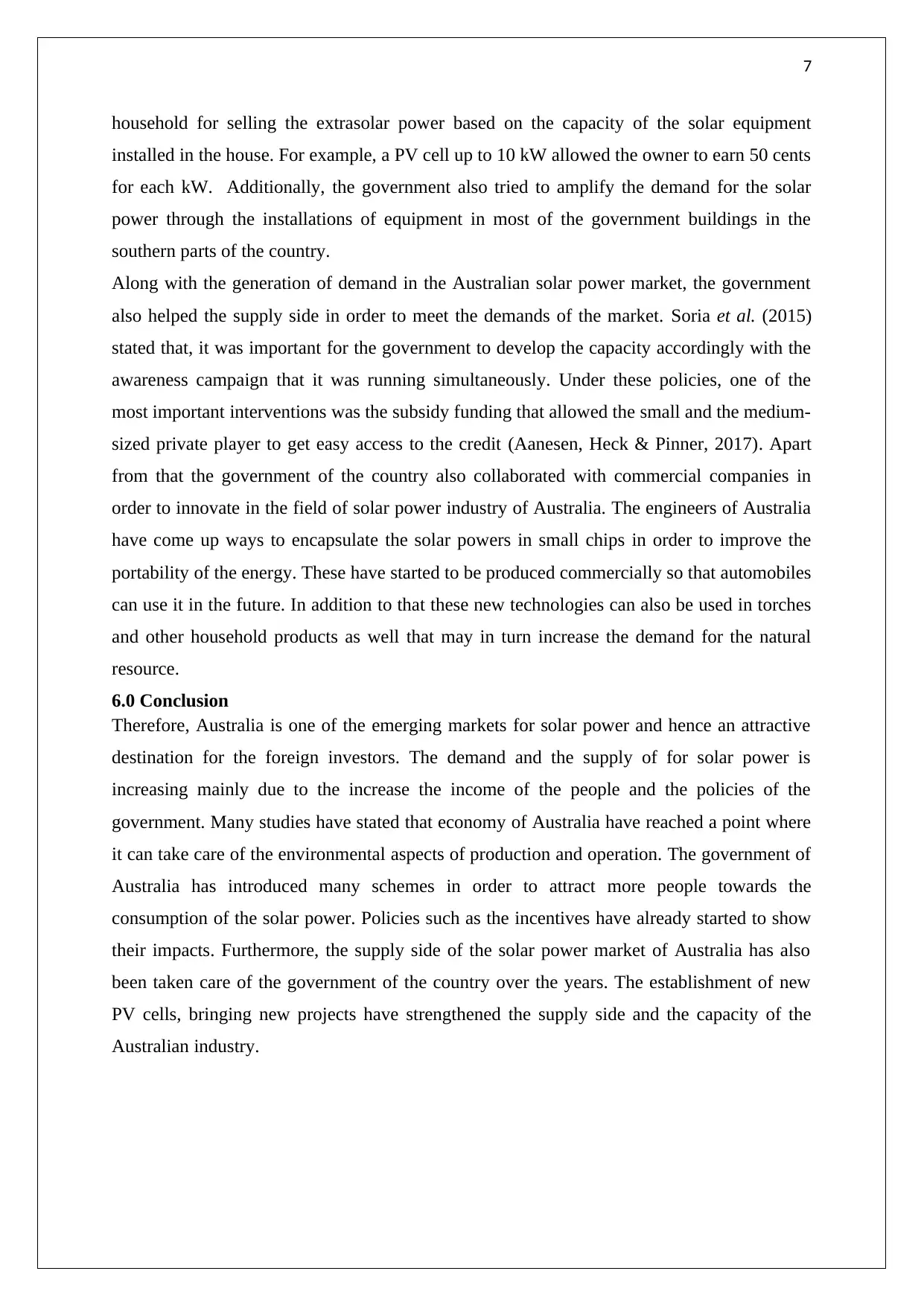
7
household for selling the extrasolar power based on the capacity of the solar equipment
installed in the house. For example, a PV cell up to 10 kW allowed the owner to earn 50 cents
for each kW. Additionally, the government also tried to amplify the demand for the solar
power through the installations of equipment in most of the government buildings in the
southern parts of the country.
Along with the generation of demand in the Australian solar power market, the government
also helped the supply side in order to meet the demands of the market. Soria et al. (2015)
stated that, it was important for the government to develop the capacity accordingly with the
awareness campaign that it was running simultaneously. Under these policies, one of the
most important interventions was the subsidy funding that allowed the small and the medium-
sized private player to get easy access to the credit (Aanesen, Heck & Pinner, 2017). Apart
from that the government of the country also collaborated with commercial companies in
order to innovate in the field of solar power industry of Australia. The engineers of Australia
have come up ways to encapsulate the solar powers in small chips in order to improve the
portability of the energy. These have started to be produced commercially so that automobiles
can use it in the future. In addition to that these new technologies can also be used in torches
and other household products as well that may in turn increase the demand for the natural
resource.
6.0 Conclusion
Therefore, Australia is one of the emerging markets for solar power and hence an attractive
destination for the foreign investors. The demand and the supply of for solar power is
increasing mainly due to the increase the income of the people and the policies of the
government. Many studies have stated that economy of Australia have reached a point where
it can take care of the environmental aspects of production and operation. The government of
Australia has introduced many schemes in order to attract more people towards the
consumption of the solar power. Policies such as the incentives have already started to show
their impacts. Furthermore, the supply side of the solar power market of Australia has also
been taken care of the government of the country over the years. The establishment of new
PV cells, bringing new projects have strengthened the supply side and the capacity of the
Australian industry.
household for selling the extrasolar power based on the capacity of the solar equipment
installed in the house. For example, a PV cell up to 10 kW allowed the owner to earn 50 cents
for each kW. Additionally, the government also tried to amplify the demand for the solar
power through the installations of equipment in most of the government buildings in the
southern parts of the country.
Along with the generation of demand in the Australian solar power market, the government
also helped the supply side in order to meet the demands of the market. Soria et al. (2015)
stated that, it was important for the government to develop the capacity accordingly with the
awareness campaign that it was running simultaneously. Under these policies, one of the
most important interventions was the subsidy funding that allowed the small and the medium-
sized private player to get easy access to the credit (Aanesen, Heck & Pinner, 2017). Apart
from that the government of the country also collaborated with commercial companies in
order to innovate in the field of solar power industry of Australia. The engineers of Australia
have come up ways to encapsulate the solar powers in small chips in order to improve the
portability of the energy. These have started to be produced commercially so that automobiles
can use it in the future. In addition to that these new technologies can also be used in torches
and other household products as well that may in turn increase the demand for the natural
resource.
6.0 Conclusion
Therefore, Australia is one of the emerging markets for solar power and hence an attractive
destination for the foreign investors. The demand and the supply of for solar power is
increasing mainly due to the increase the income of the people and the policies of the
government. Many studies have stated that economy of Australia have reached a point where
it can take care of the environmental aspects of production and operation. The government of
Australia has introduced many schemes in order to attract more people towards the
consumption of the solar power. Policies such as the incentives have already started to show
their impacts. Furthermore, the supply side of the solar power market of Australia has also
been taken care of the government of the country over the years. The establishment of new
PV cells, bringing new projects have strengthened the supply side and the capacity of the
Australian industry.
Paraphrase This Document
Need a fresh take? Get an instant paraphrase of this document with our AI Paraphraser
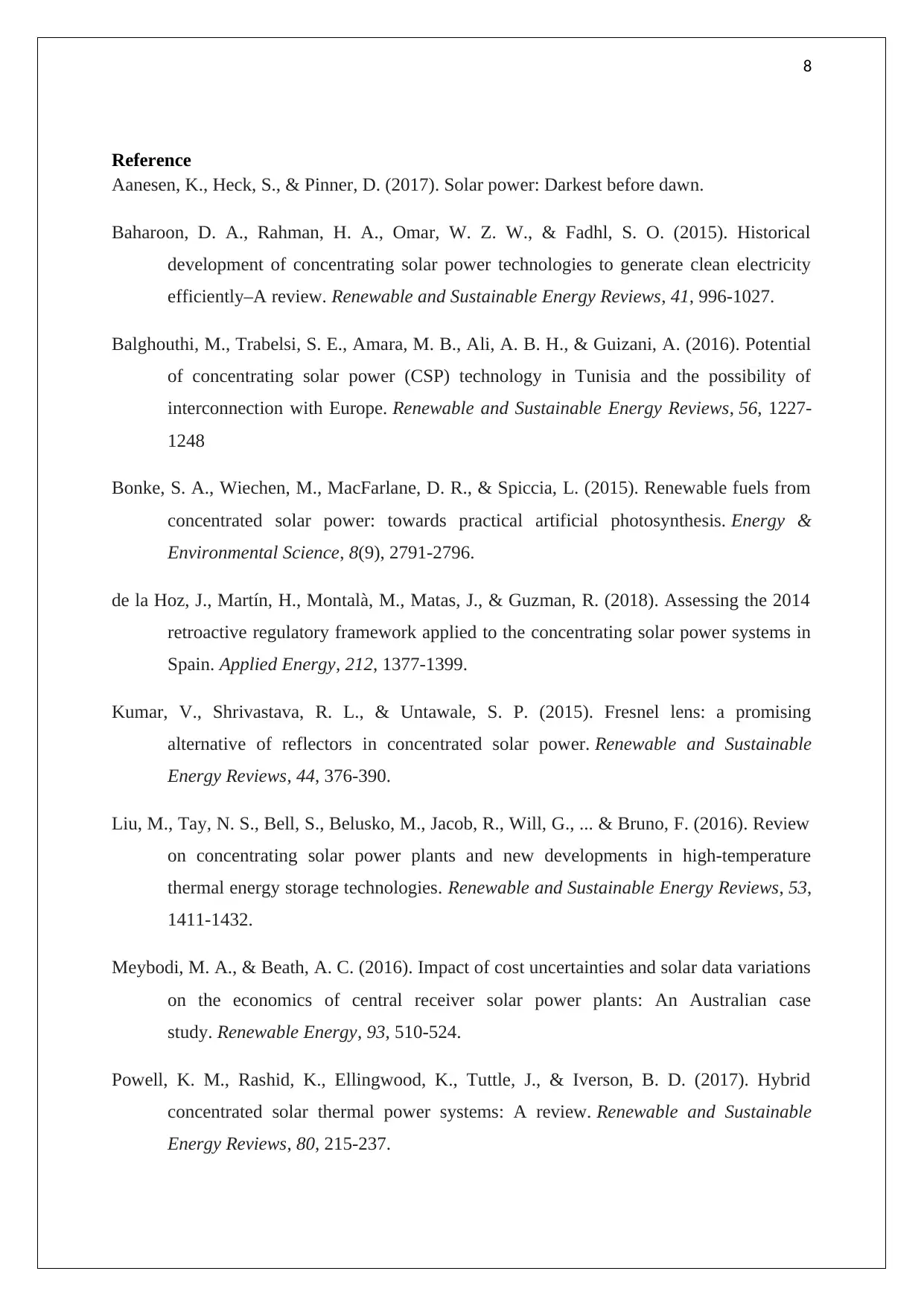
8
Reference
Aanesen, K., Heck, S., & Pinner, D. (2017). Solar power: Darkest before dawn.
Baharoon, D. A., Rahman, H. A., Omar, W. Z. W., & Fadhl, S. O. (2015). Historical
development of concentrating solar power technologies to generate clean electricity
efficiently–A review. Renewable and Sustainable Energy Reviews, 41, 996-1027.
Balghouthi, M., Trabelsi, S. E., Amara, M. B., Ali, A. B. H., & Guizani, A. (2016). Potential
of concentrating solar power (CSP) technology in Tunisia and the possibility of
interconnection with Europe. Renewable and Sustainable Energy Reviews, 56, 1227-
1248
Bonke, S. A., Wiechen, M., MacFarlane, D. R., & Spiccia, L. (2015). Renewable fuels from
concentrated solar power: towards practical artificial photosynthesis. Energy &
Environmental Science, 8(9), 2791-2796.
de la Hoz, J., Martín, H., Montalà, M., Matas, J., & Guzman, R. (2018). Assessing the 2014
retroactive regulatory framework applied to the concentrating solar power systems in
Spain. Applied Energy, 212, 1377-1399.
Kumar, V., Shrivastava, R. L., & Untawale, S. P. (2015). Fresnel lens: a promising
alternative of reflectors in concentrated solar power. Renewable and Sustainable
Energy Reviews, 44, 376-390.
Liu, M., Tay, N. S., Bell, S., Belusko, M., Jacob, R., Will, G., ... & Bruno, F. (2016). Review
on concentrating solar power plants and new developments in high-temperature
thermal energy storage technologies. Renewable and Sustainable Energy Reviews, 53,
1411-1432.
Meybodi, M. A., & Beath, A. C. (2016). Impact of cost uncertainties and solar data variations
on the economics of central receiver solar power plants: An Australian case
study. Renewable Energy, 93, 510-524.
Powell, K. M., Rashid, K., Ellingwood, K., Tuttle, J., & Iverson, B. D. (2017). Hybrid
concentrated solar thermal power systems: A review. Renewable and Sustainable
Energy Reviews, 80, 215-237.
Reference
Aanesen, K., Heck, S., & Pinner, D. (2017). Solar power: Darkest before dawn.
Baharoon, D. A., Rahman, H. A., Omar, W. Z. W., & Fadhl, S. O. (2015). Historical
development of concentrating solar power technologies to generate clean electricity
efficiently–A review. Renewable and Sustainable Energy Reviews, 41, 996-1027.
Balghouthi, M., Trabelsi, S. E., Amara, M. B., Ali, A. B. H., & Guizani, A. (2016). Potential
of concentrating solar power (CSP) technology in Tunisia and the possibility of
interconnection with Europe. Renewable and Sustainable Energy Reviews, 56, 1227-
1248
Bonke, S. A., Wiechen, M., MacFarlane, D. R., & Spiccia, L. (2015). Renewable fuels from
concentrated solar power: towards practical artificial photosynthesis. Energy &
Environmental Science, 8(9), 2791-2796.
de la Hoz, J., Martín, H., Montalà, M., Matas, J., & Guzman, R. (2018). Assessing the 2014
retroactive regulatory framework applied to the concentrating solar power systems in
Spain. Applied Energy, 212, 1377-1399.
Kumar, V., Shrivastava, R. L., & Untawale, S. P. (2015). Fresnel lens: a promising
alternative of reflectors in concentrated solar power. Renewable and Sustainable
Energy Reviews, 44, 376-390.
Liu, M., Tay, N. S., Bell, S., Belusko, M., Jacob, R., Will, G., ... & Bruno, F. (2016). Review
on concentrating solar power plants and new developments in high-temperature
thermal energy storage technologies. Renewable and Sustainable Energy Reviews, 53,
1411-1432.
Meybodi, M. A., & Beath, A. C. (2016). Impact of cost uncertainties and solar data variations
on the economics of central receiver solar power plants: An Australian case
study. Renewable Energy, 93, 510-524.
Powell, K. M., Rashid, K., Ellingwood, K., Tuttle, J., & Iverson, B. D. (2017). Hybrid
concentrated solar thermal power systems: A review. Renewable and Sustainable
Energy Reviews, 80, 215-237.
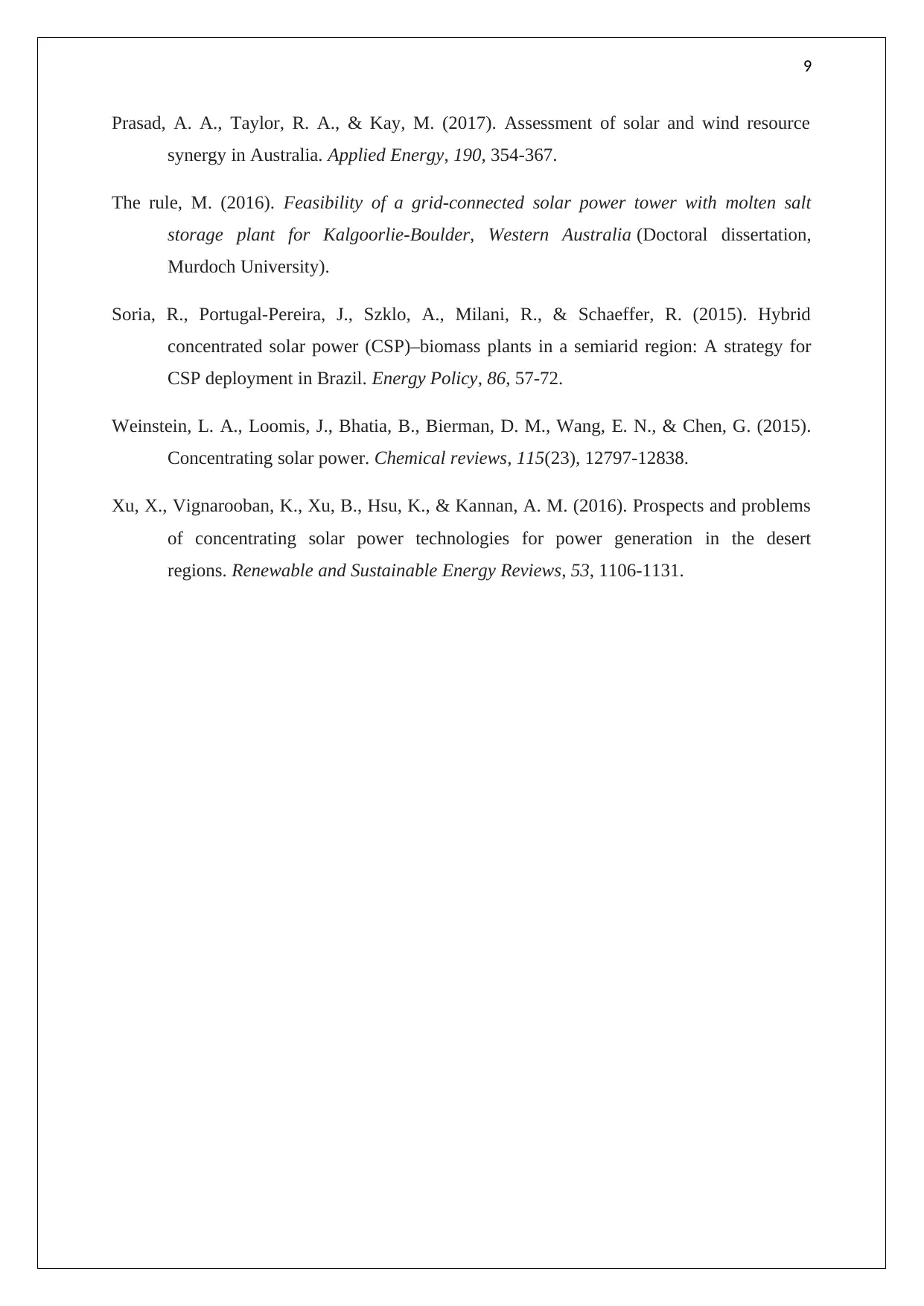
9
Prasad, A. A., Taylor, R. A., & Kay, M. (2017). Assessment of solar and wind resource
synergy in Australia. Applied Energy, 190, 354-367.
The rule, M. (2016). Feasibility of a grid-connected solar power tower with molten salt
storage plant for Kalgoorlie-Boulder, Western Australia (Doctoral dissertation,
Murdoch University).
Soria, R., Portugal-Pereira, J., Szklo, A., Milani, R., & Schaeffer, R. (2015). Hybrid
concentrated solar power (CSP)–biomass plants in a semiarid region: A strategy for
CSP deployment in Brazil. Energy Policy, 86, 57-72.
Weinstein, L. A., Loomis, J., Bhatia, B., Bierman, D. M., Wang, E. N., & Chen, G. (2015).
Concentrating solar power. Chemical reviews, 115(23), 12797-12838.
Xu, X., Vignarooban, K., Xu, B., Hsu, K., & Kannan, A. M. (2016). Prospects and problems
of concentrating solar power technologies for power generation in the desert
regions. Renewable and Sustainable Energy Reviews, 53, 1106-1131.
Prasad, A. A., Taylor, R. A., & Kay, M. (2017). Assessment of solar and wind resource
synergy in Australia. Applied Energy, 190, 354-367.
The rule, M. (2016). Feasibility of a grid-connected solar power tower with molten salt
storage plant for Kalgoorlie-Boulder, Western Australia (Doctoral dissertation,
Murdoch University).
Soria, R., Portugal-Pereira, J., Szklo, A., Milani, R., & Schaeffer, R. (2015). Hybrid
concentrated solar power (CSP)–biomass plants in a semiarid region: A strategy for
CSP deployment in Brazil. Energy Policy, 86, 57-72.
Weinstein, L. A., Loomis, J., Bhatia, B., Bierman, D. M., Wang, E. N., & Chen, G. (2015).
Concentrating solar power. Chemical reviews, 115(23), 12797-12838.
Xu, X., Vignarooban, K., Xu, B., Hsu, K., & Kannan, A. M. (2016). Prospects and problems
of concentrating solar power technologies for power generation in the desert
regions. Renewable and Sustainable Energy Reviews, 53, 1106-1131.
⊘ This is a preview!⊘
Do you want full access?
Subscribe today to unlock all pages.

Trusted by 1+ million students worldwide
1 out of 9
Related Documents
Your All-in-One AI-Powered Toolkit for Academic Success.
+13062052269
info@desklib.com
Available 24*7 on WhatsApp / Email
![[object Object]](/_next/static/media/star-bottom.7253800d.svg)
Unlock your academic potential
Copyright © 2020–2025 A2Z Services. All Rights Reserved. Developed and managed by ZUCOL.





